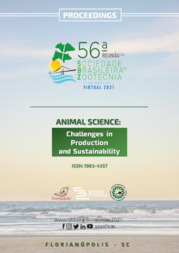Liver parameters of beef cattle intensively grazed and supplemented with non-antibiotic additives as a substitute for antibiotics.
Liver parameters of beef cattle intensively grazed and supplemented with non-antibiotic additives as a substitute for antibiotics.
Author(s): PEREIRA, D. H.; ANJOS, E. dos; GALATTO, A.; ROECKER, A. N.; PRADO, T. A.; PEDREIRA, B. C. e
Summary: The inclusion of high doses of concentrate in the diet of cattle promotes changes in metabolic activity, as well as in the organs. However, this high activity can lead to hepatic alterations, due to the characteristic of an organ of high activity in nutrient metabolism. The aim of this study was to evaluate the influence of non-antibiotic additives to replace antibiotics in the diet of cattle raised on intensive pasture on liver parameters. The experiment was conducted at Embrapa Agrossilvipastoril, in Sinop - Mato Grosso. Forty cattle of the Nelore breed, uncastrated, with mean age of 22 ± 2 months and mean initial body weight of 415 ± 5 kg, were randomly divided into four treatments: supplement containing non-ionophore additive (0.07 g kg DM-1 of virginiamycin) (VM); supplement containing yeast-based probiotic (3 g per 100 kg body weight) to replace virginiamycin (ADV); supplement containing 1.4 g kg DM-1 of tannin to replace virginiamycin (TN1.4); supplement containing 2.1 g kg DM-1 of tannin to replace virginiamycin (TN2.1). Blood samples were collected via tail vein puncture at the adaptation and at the end of the experiment, and all animals were sampled. The samples were centrifuged, aiming the separation of serum, for the analysis of blood parameters. At the end of the experiment all animals were slaughtered, and the liver weights of each animal were recorded. The means of the treatments were analyzed via PROC MEANS of SAS and the means were compared using the Tukey test (α = 0.10). There was no difference between the additives for liver weight in kg (P = 0.373) and carcass percentage (P = 0.801). Lactate concentrations were not influenced by the additives (P = 0.419). Serum concentrations for glutamic-oxalacetic transaminase (GOT) and glutamic-pyruvic transaminase (GPT) were higher in VM and TN 1.4 treatments (P < 0.10), with mean values of 52.0 U L-1 and 94.45 U L-1, respectively. The enzymes GOT and GPT are markers of liver injury and can be found in both the cytoplasm and mitochondria of liver cells, where concentrations above 130 U L-1 for GOT and above 118 U L-1 for GPT indicate changes in liver tissue. From the evaluation of hepatic metabolic parameters and liver evaluation, no evidence was found to show liver injury, with enzyme concentrations being below the upper limit of ideal. Based on the evaluation of liver parameters of animals receiving high levels of supplementation we can conclude that non-antibiotic additives can be added to the diet of intensively grazed cattle, replacing virginiamycin.
Publication year: 2021
Types of publication: Abstract in annals or event proceedings
Keywords: Beef cattle, Gado de Corte, Mato Grosso, Nellore, Sinop-MT, Suplemento Alimentar, Tannins, Virginiamycin
Observation
Some of Embrapa's publications are published as ePub files. To read them, use or download one of the following free software options to your computer or mobile device. Android: Google Play Books; IOS: iBooks; Windows and Linux: Calibre.
Access other publications
Access the Agricultural Research Database (BDPA) to consult Embrapa's full library collection and records.
Visit Embrapa Bookstore to purchase books and other publications sold by Embrapa.

